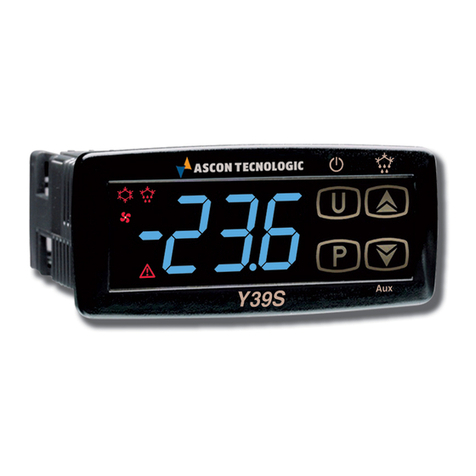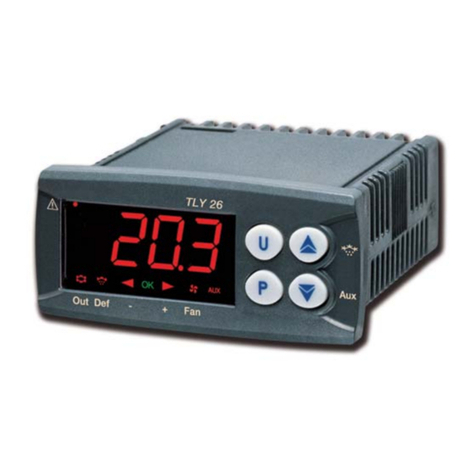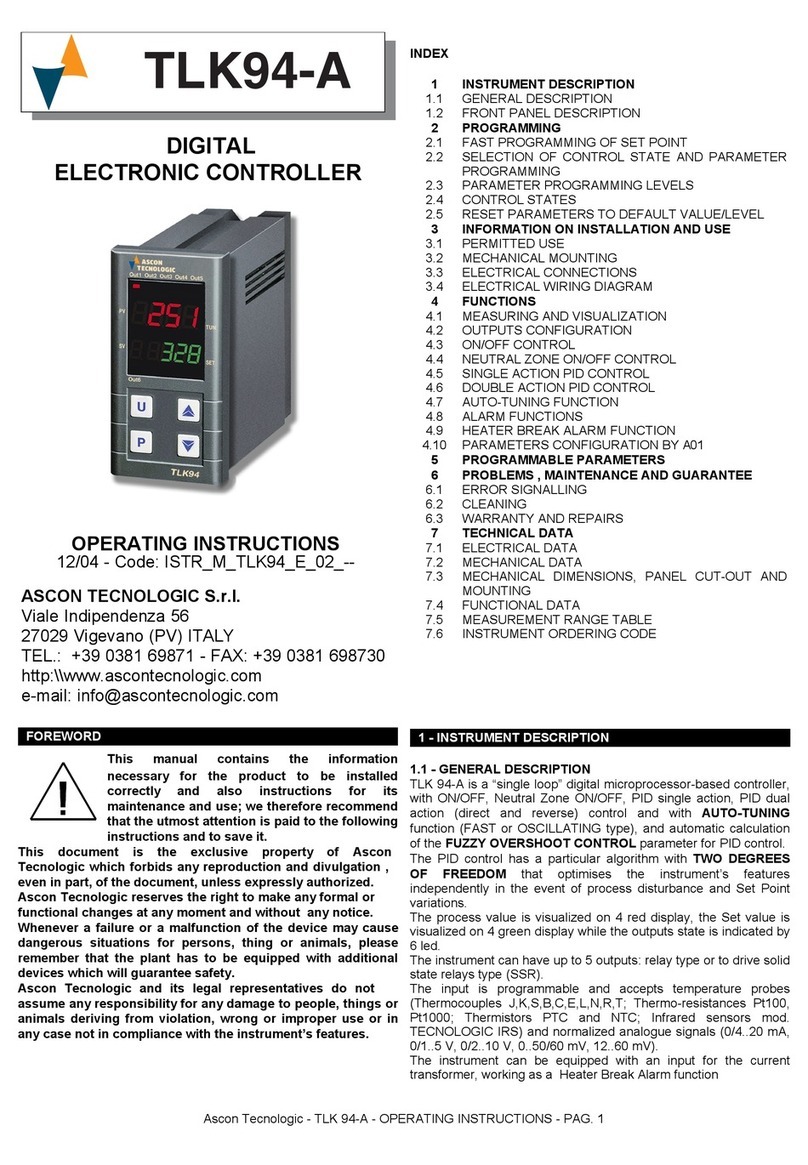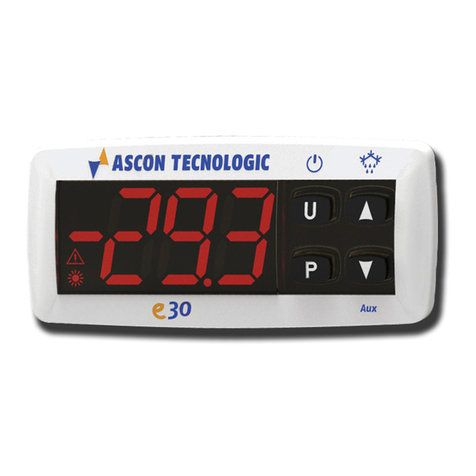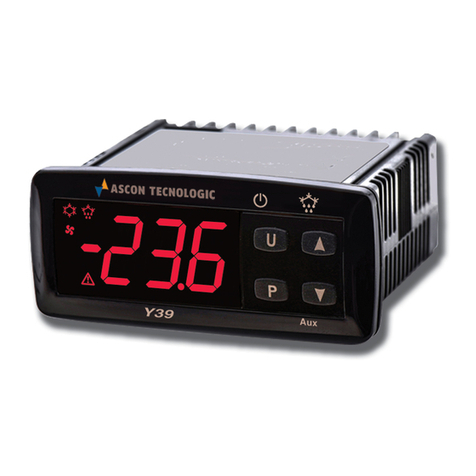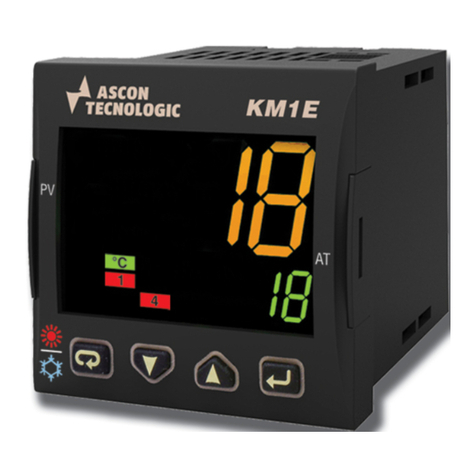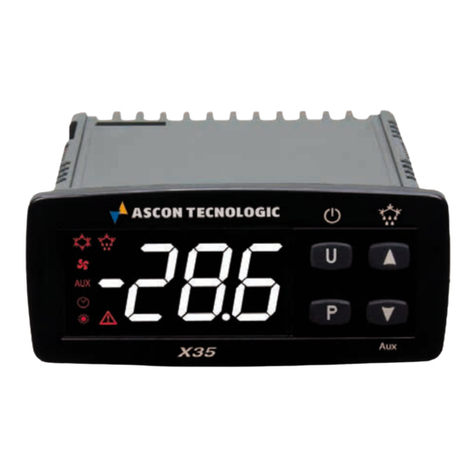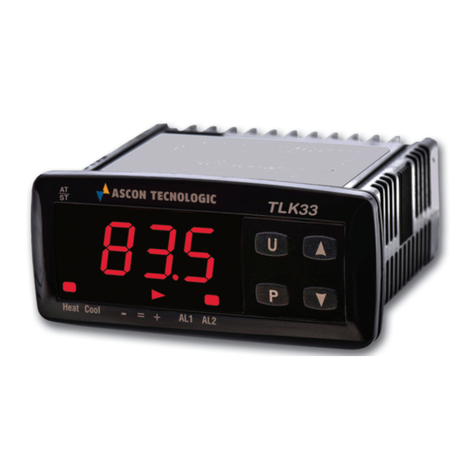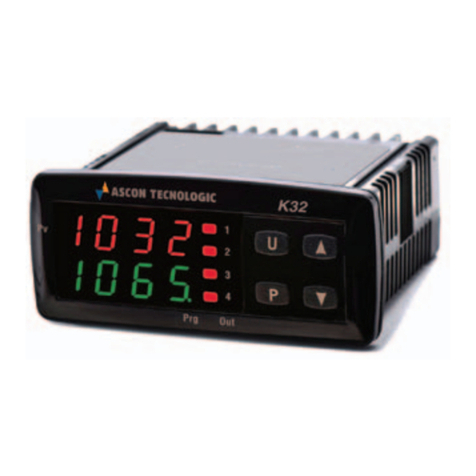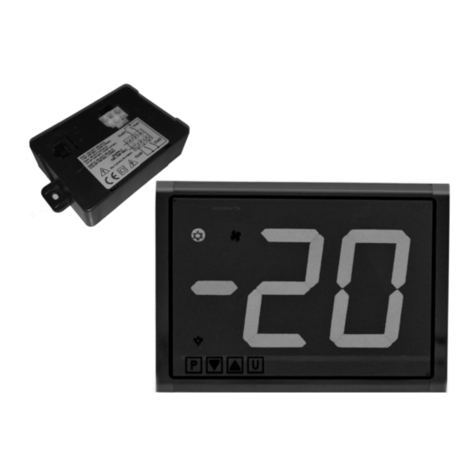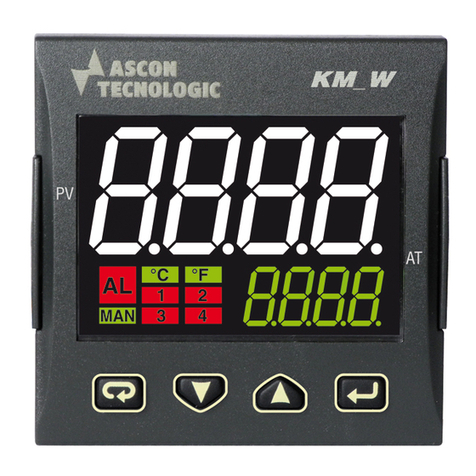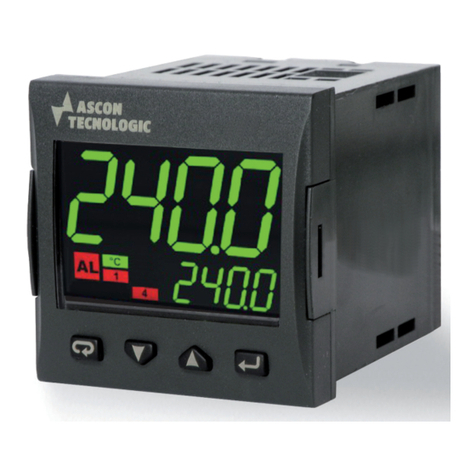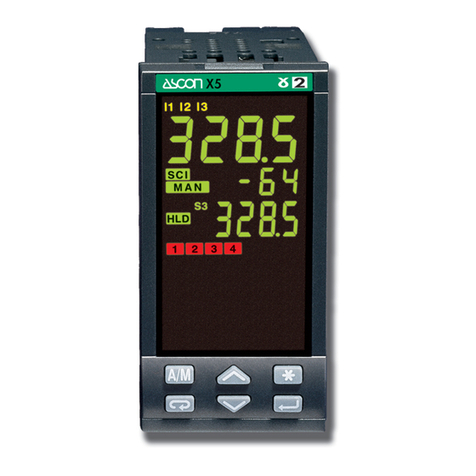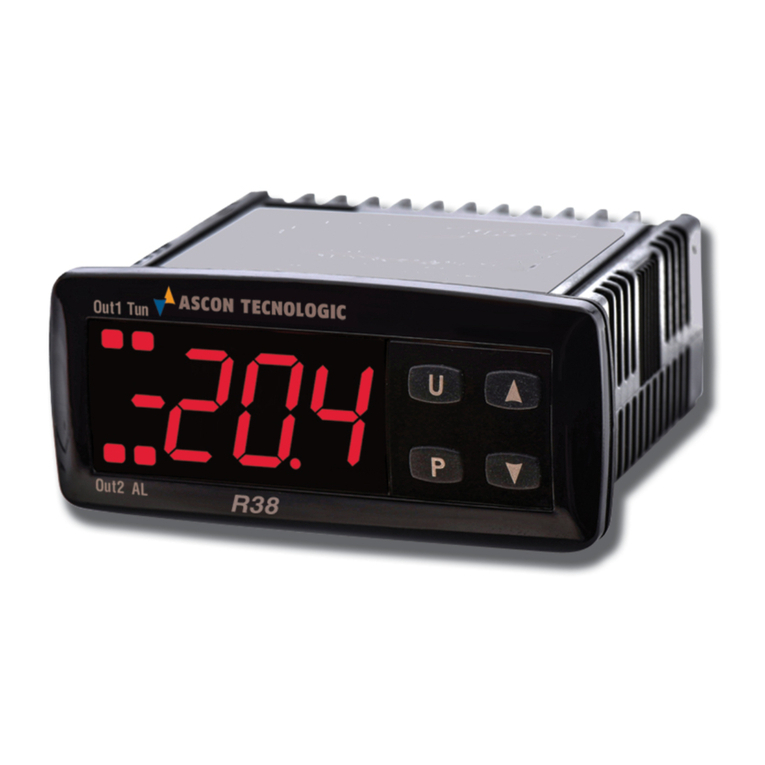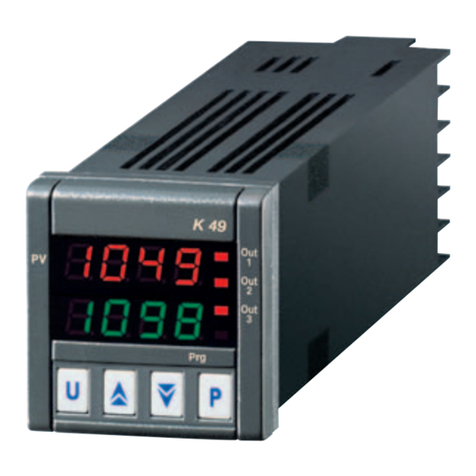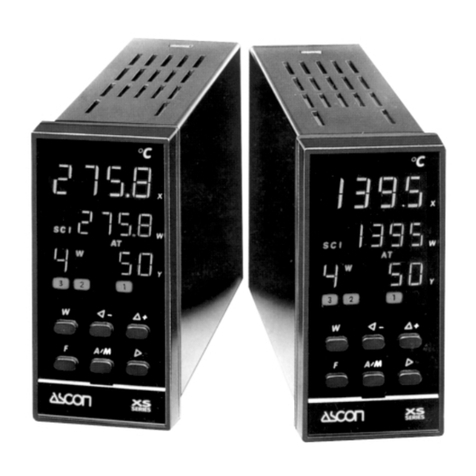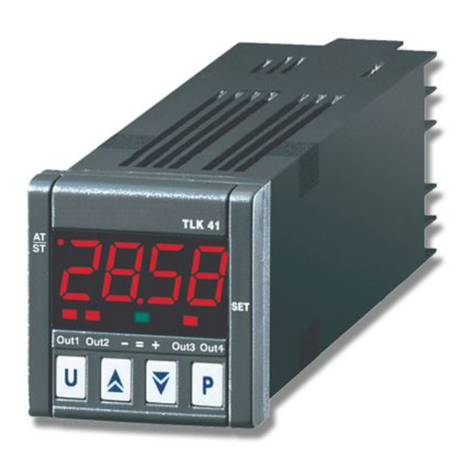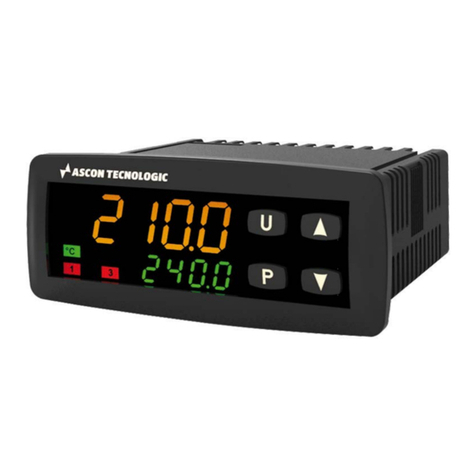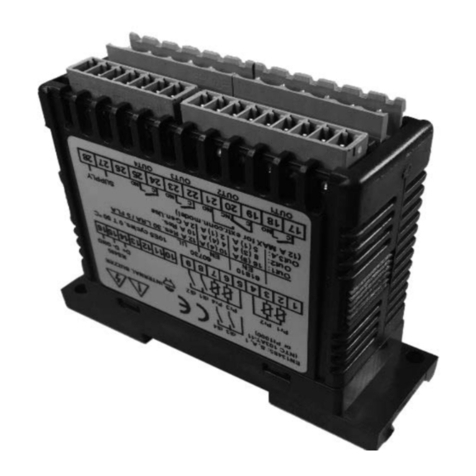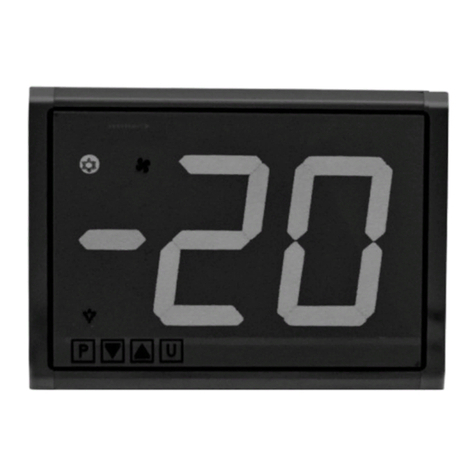
Ascon Tecnologic Srl - X33H – OPERATING INSTRUCTIONS – MX33HENG00 - PAGE 9
4.13.2 - EXTERNAL ALARM
The appliance may signal an external alarm by activating a digital
input with function programmed as “diF ” = 1, 2, 3, 4 (see digital
inputs).
At the same time as the alarm signal configured (buzzer and/or
output), the appliance signals the alarm by switching on the ALARM
LED, and alternately showing on the upper display AL and the
variable established in the “diSU” par..
4.13.3 - DOOR OPEN ALARM
The appliance may signal a door open alarm by activating a digital
input with function programmed as “diF ” = 5, 6, 7 (see digital
inputs).
Upon the activation of the digital input and after the delay
programmed in the “oAd” par., the appliance signals the alarm by
activating the buzzer and the output (if present), switching on the
ALARM LED, and alternately showing on the upper display “AdoP”
and the variable established in the “diSU” par..
If the operation of the digital input envisages the blocking of some
loads (recycling fans etc.) upon the triggering of the door open
alarm, the utilities are reactivated even if the digital input remains
active.
4.13.4 - ALARM MEMORY
The appliance offers the possibility of availing of the alarm memory
function by means of the “tAL” par..
If "tAL" = no, the appliance cancels the alarm signal when the alarm
conditions have ceased; if, however, it is programmed as "yES", the
ALARM LED continues to flash after the cessation of the alarm
conditions, too, to indicate that an alarm has been signalled.
To cancel the alarm memory signal, press any key.
Remember that if it is wished to have the operation of an output (or
the buzzer) with alarm memory (=ALL or =-ALL), it is necessary to
set the “tAL” par. = yES.
4.14 - OPERATION OF THE “U”, “UP/F1, AND “DOWN/F2”
KEYS
Three of the keys of the appliance can be configured to operate
other commands, in addition to their normal functions.
The function of the U key can be defined using the “USrb”
parameter, that of the UP/F1 key using the “Fbu” par., and that of
the DOWN/F2 key by means of the “Fbd” par., all contained in the
“
]
PAn” group.
The three parameters offer the same possibilities and can be
configured for the following operations:
= OFF - the key does not carry out any function.
= 1 - Pressing the key for at least 1 sec. it is possible to
activate/deactivate the light output (LIGH)
= 2 - Pressing the key for at least 1 sec. it is possible to
activate/deactivate the auxiliary output (AUS) configured as
“FOA”=2.
= 3 - Pressing the key for at least 5 sec. it is possible to
activate/deactivate the manual defrosting cycles.
= 4 - Pressing the key for at least 1 sec. it is possible to switch the
appliance from the ON state to the Stand-by state and vice versa.
= 5 - Pressing the key for at least 1 sec. it is possible start/stop an
air recycling cycle.
= 6 - Pressing the key for at least 1 sec. it is possible start/cancel
(START/STOP) a work cycle.
= 7 - Pressing the key for at least 1 sec. it is possible start/stop
(START/PAUSE) a work cycle. In this mode, by keeping the key
pressed for 5 sec. it is possible to cancel the cycle in progress
(STOP).
4.15 - DIGITAL INPUTS
All the parameters regarding the functions of the digital inputs are
contained in the “
]
din” group.
The appliance envisages up to 3 digital inputs for contacts free from
voltage, of which one is always available while the other 2 can be
used as an alternative to the Pr2 and Pr3 sensors.
The use of these inputs as digital inputs is established by the setting
of the “Pr2” and “Pr3” parameters = diG.
The functions carried out by the digital inputs can be defined by
means of the “diF1”, “diF2”, and “diF3” parameters, and the
actions can be delayed with the times set respectively in the
“did1”, “did2”, and “did3” parameters.
The “diF” parameters can be configured for the following operations:
= 0 - Digital input not active
= 1 - Signalling of an external alarm with contact normally open:
upon the closure of the input (and after the “did” time), the alarm is
activated and the appliance alternately shows on the upper display
AL and the variable established in the “diSU” par..
= 2 - Signalling of an external alarm with deactivation of all the
control outputs by means of normally open contact: upon the
closure of the input (and after the “did” time), all the control outputs
(HEAt, CooL, rh, drh, FAnr, FanE, dEF, AuS) are deactivated, the
alarm is activated and the appliance alternately shows on the upper
display AL and the variable established in the “diSU” par..
= 3 - Signalling of an external alarm with deactivation of the HEAt
output by means of normally open contact: upon the closure of the
input (and after the “did” time), the HEAt output is deactivated, the
alarm is activated and the appliance alternately shows on the upper
display AL and the variable established in the “diSU” par..
= 4 - Signalling of an external alarm with deactivation of the CooL
output by means of normally open contact: upon the closure of the
input (and after the “did” time), the CooL output is deactivated, the
alarm is activated and the appliance alternately shows on the upper
display AL and the variable established in the “diSU” par..
= 5 - Cell door open with only light switching on: upon the activation
of the input (and after the “did” time), the output configured as LIGh
is activated and the appliance alternately shows on the upper
display AdoP and the variable established in the “diSU” par.. With
this operating mode, the action of the digital input also activates the
time that can be set in the "oAd" par., upon the expiry of which the
alarm is activated to signal that the door has remained open. When
the input is deactivated, the LIGH output is switched off. If the
LIGHT output has already been activated by means of a configured
key (see operation of keys), the state of the input has no effect and
the output must be switched off using the key.
= 6 - Cell door open with light switching on and stoppage of
recycling fans by means of normally open contact: upon the
activation of the input (and after the “did” time), as well as the light
switching on (see “diF”= 5), the recycling fans (FAnr) are stopped
and the appliance alternately shows on the upper display AdoP and
the variable established in the “diSU” par.. As in the previous mode,
the action of the digital input also activates the time that can be set
in the "oAd" par., after which the alarm is activated to signal that the
door has remained open. On the occurrence of the door open
alarm, the recycling fans are then re-started.
= 7 - Cell door open with light switching on and with stoppage of
fans and actuators by means of normally open contact: similar to
“diF” = 6 but with disabling of both the recycling fans (FAnr) and the
actuators (HEAt. CooL, rh, drh). On the occurrence of the door open
alarm, the recycling fans and the actuators are then re-enabled.
= 8 - Start defrosting command with normally open contact: upon
the closure of the input (and after the “did” time), a defrosting cycle
is activated.
= 9 - End defrosting command with normally open contact: upon the
closure of the input (and after the “did” time), the defrosting cycle is
terminated if it is in progress, or defrosting is blocked.
= 10 - Switch on/Switch off(Stand-by) of the appliance with normally
open contact: upon the closure of the input (and after the “did”
time), the appliance is switched on, while when it is opened, the
appliance is put into the Stand-by state.
Upon switching off, this command has priority over the key, thus if a
digital input is programmed = 10 and the input is not active, the
controller cannot be switched on by the key. However, if the input
remains active, the controller can be switched on/off using the
configured key, but when the input is deactivated, it is in any case
switched off.
= 11 - Air exchange cycle enabling command with normally open
contact: upon the closure of the input (and after the “did” time), a
work cycle is activated.
If the work cycle is already in progress, the command interrupts the
air exchange cycle in progress.
